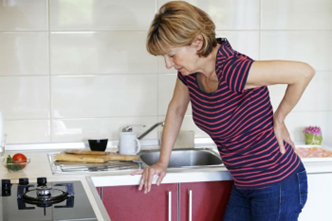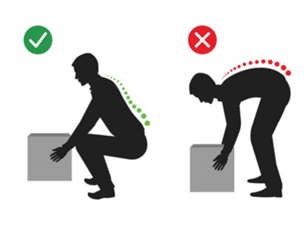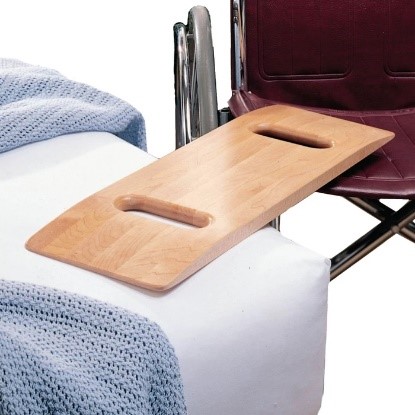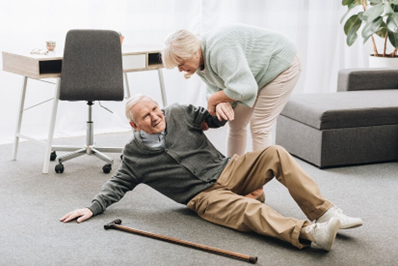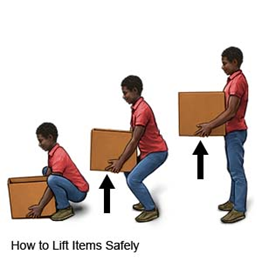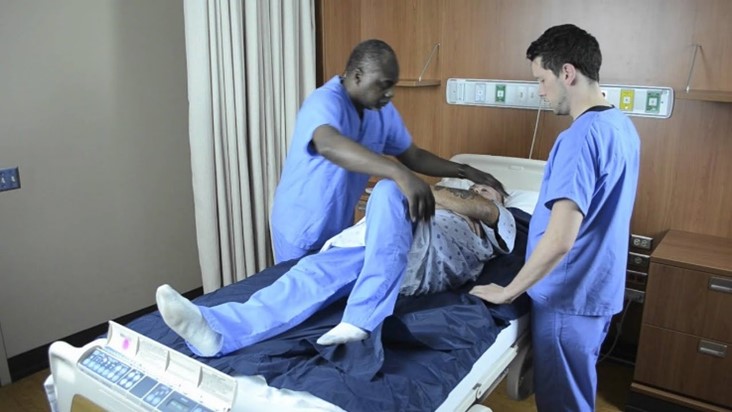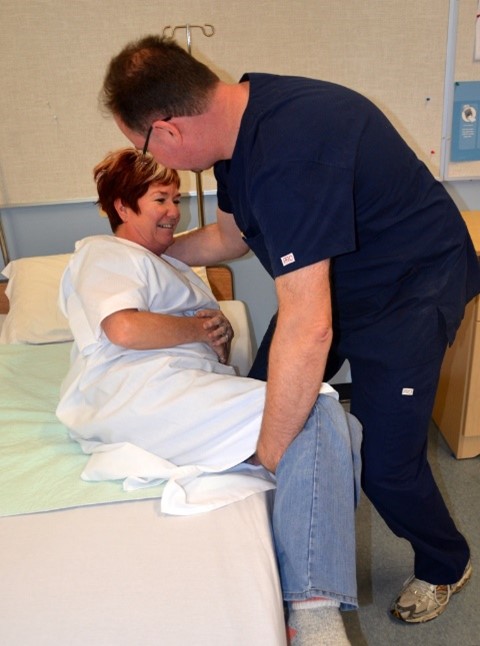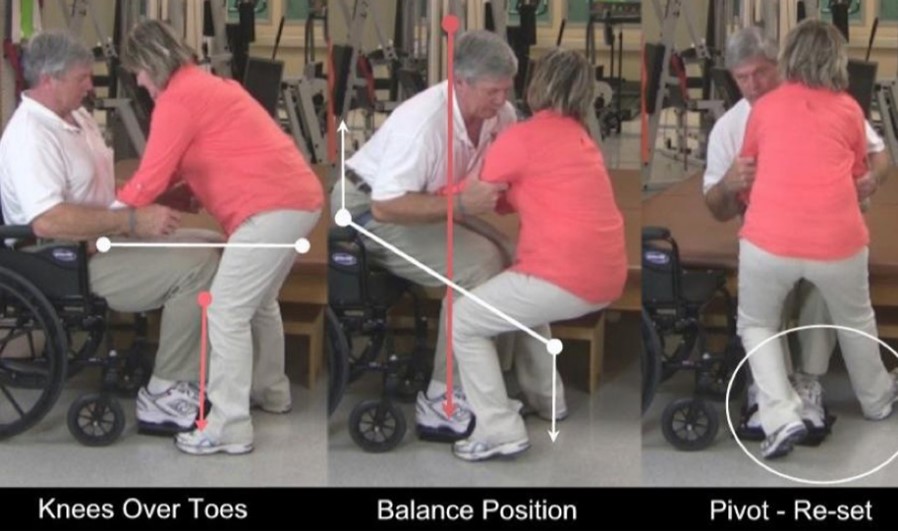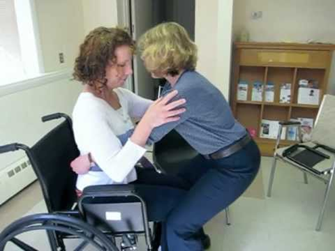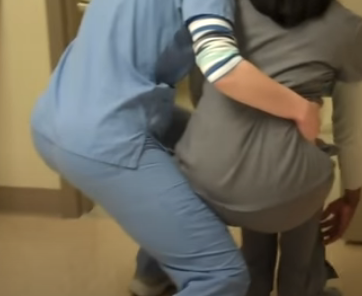In-Home Caregiver skill- Proper Lifting
In-Home Caregiver skill- Proper Lifting
Author: Mark Parkinson BsPharm: President AFC-CE
Credit Hours 2 - Approximate time required: 120 min.
Educational Goal
Teach In-Home care providers how to safely lift and handle resident falls.
Educational Objectives
- Inform homeowners of their responsibility in providing training
- Present a program of lifting education.
- List different types of lifting assist equipment
- Cover how to handle resident falls
Procedure:
Read the course materials. 2. Click on exam portal [Take Exam]. 3. If you have not done so yet fill in Register form (username must be the name you want on your CE certificate). 4. Log in 5. Take exam. 6. Click on [Show Results] when done and follow the instructions that appear. 7. A score of 70% or better is considered passing and a Certificate of Completion will be generated for your records.
Disclaimer
The information presented in this activity is not meant to serve as a guideline for patient management. All procedures, medications, or other courses of diagnosis or treatment discussed or suggested in this article should not be used by care providers without evaluation of their patients’ Doctor. Some conditions and possible contraindications may be of concern. All applicable manufacturers’ product information should be reviewed before use. The author and publisher of this continuing education program have made all reasonable efforts to ensure that all information contained herein is accurate in accordance with the latest available scientific knowledge at the time of acceptance for publication. Nutritional products discussed are not intended for the diagnosis, treatment, cure, or prevention of any disease.
In-Home Caregiver skill- Proper Lifting
The Blessing and Curse of a Home Care.
Your residents love the laid-back atmosphere of living in a real home. The familiar comforts of home care versus the harsh surrounding of an institutional care setting are a real blessing to them. The curse side of the coin is that home-based care lacks the additional resources found in larger healthcare settings. In a hospital setting if a patient needs to be moved there are machines, devices, and plenty of staff to make the transfer safe for both patient and caregivers. In foster care homes those devices are missing. When a resident needs to be moved or picked up the care provider has to do all the work. If the lift is done improperly the possibility of a career-ending back injury is very real.
Year after year healthcare workers are listed among the professions with the greatest percentage of disabling back injuries. The primary cause of injury is the manually lifting of patients. In nursing homes, it has been reported that injuries to certified nursing assistants (those who actually do the lifting) are three to four times that of registered nurses. The incidents of back injuries among healthcare workers are as high or higher than many professions considered dangerous or hazardous. To make the issue even more serious for care homes. If a CNA gets injured they put them on light duty or hire another CNA. If a foster care owner is injured the business closes. For a foster care home nothing is more serious than that.
Lacking the additional resources and manpower, foster care providers have to mitigate the risk of back injury by working smarter than the problem. Working smarter means acknowledging the risk of injury is real and thinking thru every occurrence of lifting heavy objects. Just because you work in a casual environment doesn’t mean you can be casual about lifting. Care homeowners must make sure that all workers are familiar with the proper techniques of lifting and all care providers need to review those principles on a regular basis.
The rest of this lesson is written as if it is to be used as a training program. I give permission for Care homeowners to copy any portion of this lesson for use in their own business.
In-Home Caregiver Program
Patient Transferring, Lifting, and Falls
Information for Owners - Management Involvement
No program will last for long without the involvement of the boss. Owners of care homes should:
- Establish practices and policies for safe patient handling. Owners have to communicate to everyone how to properly and safely lift. You’ll find the easiest way to accomplish this goal is by setting up a program that everyone has to go through.
Elements of such a program are:
- communicate the importance of proper techniques.
- a training program
- a test to demonstrate knowledge gained
- follow through.
One idea for training and testing is for the owner or other caregiver to become the patient. Showing and actual hands-on practice, along with reading, is a powerful way to teach.
- Supply the proper equipment and resources to accomplish the lifting task. I think I just heard a collective moan from the owners’ wallets. While it is true that a small business must keep expenses down, you’ll find that the proper tool at the proper time does save more money than the tool itself. An inexpensive transfer belt is a lot cheaper than increased worker compensation premiums. More on equipment later. A lot of resources don’t cost any money. These include team lifts. The more bodies that lift, the easier the lifting task is. Owners must establish an environment where workers can ask for and get the assistance they need. If you are getting those types of phone calls, your lifting program is working.
- Follow through. It’s one thing to establish a program. It is another to do the program, employee after employee, year after year. A check-off form attached to the employee’s file will help. Make it a habit. Also, keep track of the equipment. Make sure it doesn’t walk off on its own or need repair. Periodically, it is good to ask questions of your employees. Ask them what they need, which tasks are the hardest, should the home be rearranged to make the job easier or safer. This accomplishes several things. Employees can sometimes come up with some pretty good suggestions. It strengthens employee-owner relations. It serves as a reminder of lifting protocols are important. Follow-through is simply a good business practice.
- If an injury occurs, reporting it should be one of the first steps. The owner has to create an environment where the employee feels safe reporting an injury. Once informed, the owner has to report it to their worker's compensation insurance program. It’s the law. Failure on either count might lead to denial of a claim, negligence charges, and lawsuits or worse.
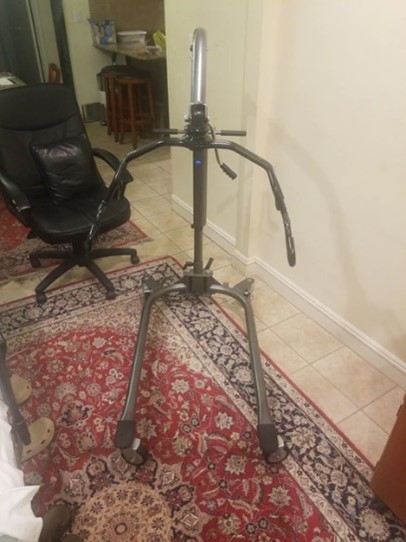 Lifting and Transferring Equipment
Lifting and Transferring Equipment
With medical costs and insurance skyrocketing, large nursing homes and hospital corporations are spending millions on new lifting equipment and implementing no-lift policies. Countries such as Australia have even gone as far as writing the requirements into law. Care homes do not have those resources, but some savvy owners are upgrading their own homes in a more cost-effective way. Make connections with the large health institutions’ equipment managers in your area and you might pick up a good deal on used equipment. Also, keep an eye on second-hand stores where some medical devices can be purchased for pennies on the dollar. You might advertise on the Internet or local newspaper to purchase used equipment.
 New patient transfer equipment that is well within the reach of most care home budgets includes:
New patient transfer equipment that is well within the reach of most care home budgets includes:
- Transfer or Gait Belts
Traditionally, these were belt-like devices made out of canvas with a metal cinch clasp on one end. It was placed around the hips of the patient, giving caregivers a convenient place to hold on to. While those old belts can still be purchased for less  than $5.00 a piece used, they are being replaced by gait belts with a superior design. The new designs are two to three times as wide, made of easy-to-clean synthetic materials, a quick-release plastic clasp, and multiple soft handle loops sticking out. They are easier to use and clean than the older version. They cost a bit more, but new units cost less than $40.00.
than $5.00 a piece used, they are being replaced by gait belts with a superior design. The new designs are two to three times as wide, made of easy-to-clean synthetic materials, a quick-release plastic clasp, and multiple soft handle loops sticking out. They are easier to use and clean than the older version. They cost a bit more, but new units cost less than $40.00.
A transfer board is any material or object that can hold up under the weight of the patient that they can slide on to get from one place to another. Literally, a highly polished board with a good finish will do the trick. Commercial versions are much easier to use for the caregiver and the patient. Transfer boards come in astounding varieties, ranging from simple ones running about $10-20 to extremely versatile or specialized units going for hundreds of dollars.
- Swivel Boards or Discs
These devices are placed under the feet of the patient to assist in turning in the pivot-transfer method. They are designed to function even with the heaviest patients. Simple units are fairly cheap. Complex quality units can run up to hundreds of dollars.
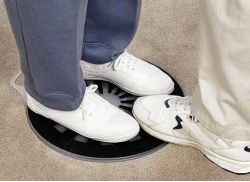 |
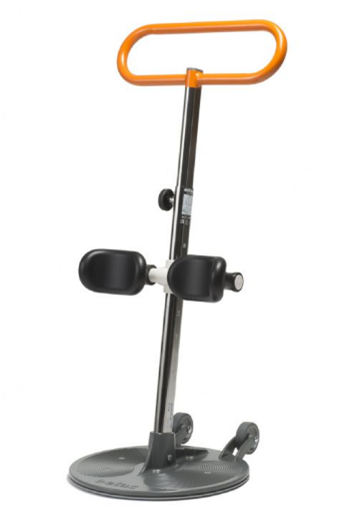 |
- Transfer Benches
A transfer bench is a cross between a bath bench and a transfer board. All are designed to be bathtub capable. The simplest is just bath benches that are long enough to extend over the bathtub side wall. Used versions can be picked up inexpensively. More advanced versions come complete with swivel chairs mounted on rollers. They make bathing your residents very easy and virtually fall-free. They run up to $500, depending on how many features you want. Good units can be purchased for around $200- $400 each.
- Power Lifts
Power lifts are any powered device that aids in a patient's standing or transferring. These are the most expensive, with some devices running thousands of dollars. The most common versions in care homes are power lift recliner chairs that residents bring with them from home. Make arrangements to purchase used chairs when a client moves on. Or better yet ask the family member to donate the chair.
- Stand-Assist Devices
Stand–assist devices are basically, handles that the patient holds on to while they stand. The patient uses them to pull themselves up. The model can be free-standing or fixed to a bed, or chair. There is even a version that attaches to the top of a car door which makes it easier to get in and out of the car. These are simple devices and most can be purchased for $100 or less.
Insurance Coverage
Depending on the patient’s diagnosis, some devices are covered by insurance. A durable medical device salesman can assist you with the particulars of the paperwork. A prescription will likely be needed. It would be to your benefit to learn about the insurance process so you can utilize the coverage in similar future circumstances.
Care Provider Training Program
Overview
Every year, thousands of healthcare workers go to work to help their patients only to have a lifting injury and become a patient themselves. It is ironic that the act of assisting the patient, if not properly done, may cause harm to that very patient. To help keep you and your charges from unwanted injury, the following program was developed.
A well-meaning caregiver about to hurt her back
Awareness
In-home caregiving may seem like an easy job, but at times it can be quite physically demanding. The caregiver must take the responsibility to always be aware of what is required of them and accomplish those tasks safely. Do not fall into the trap of doing things the quick and sloppy way. Such thinking has led to many patient injuries, caregiver back surgeries, and lives full of pain.
If an injury does occur, report it immediately. A stitch in time really does save nine. No one wants to see you injured or work while you are in pain. Call the management at any time when there is a need. Help will always be there for you.
Limitations
Remember that when you work with the elderly or bedridden, inactivity and osteoporosis rob the bones of their strength and make them brittle. Arthritis can result in sore and stiff joints, making regular movements difficult. It’s easy to get dizzy if you get up too fast. Some patients have injuries that make one side weaker than the other. Always try to compensate for the weak side.
Before the Lift
Think about what you are doing. Figure out the proper lifting technique for the task at hand. Utilize the proper equipment, clear the area or path of hazards, and get help if you need it. Gather the items you need before the lift or transfer. Never leave an “at-risk” person alone in a precarious position.
A Special Note: Get Help
You are not in this alone, and you are not superhuman. If the lifting is too heavy, get help, either from the proper equipment available or the assistance of someone else. Many hands always make lifting easier and safer.
Know Your Patients
Everyone has varying capabilities and weaknesses. If you are new to the job, make it a priority to learn what disabilities your charges have. Don’t be surprised in the middle of a lift that a patient can’t do this or that function. Always be aware that patients can have bad days that reduce their capacities.
Proper Body Mechanics
Every lifting job is different, but there are common elements to all proper lifts or patient transfers
- Face the person or object and establish a solid base of support. Place your feet shoulder length apart on the solid, slip-free ground.
- Keep your back straight.
- Bend at the knees and not the lower back as much as possible.
- Hold the object as close to you as possible.
- Tighten your stomach muscles when lifting.
- Lift as much as you can with your legs.
- Never twist when you lift. Make adjustments with your footing instead.
- Push rather than pull when you can.
- Maintain good communication in team lifts.
- Lift with smooth efforts, with no sudden jerking.
Patients are not the only heavy things that you might be required to lift. A 25-pound bag of potatoes, flipping a mattress, or moving furniture around can overstrain the back if improper body mechanics are used.
Patient Transfers
Moving a patient from one place to another is an essential required skill for any caregiver. But awkward positions, tight, in-home spaces, and unpredictable patient movements can make transferring a patient a dangerous task. Over the years, techniques have been developed that will enable you to move the patient easily and safely.
Rolling a Patient in Bed
- Ensure that there is enough room to roll the patient in the direction that is needed.
- Have the patient bend the opposite knee in the direction you want to roll.
- Cross the opposite arm you want to go and have the patient reach in that direction
- Place your hands on the shoulder and hip area and gently push until the roll is complete.
Setting the Patient on the Edge of the Bed From a Reclining Position
- Bring the patient to the edge of the bed. This may take leveraging from top to bottom a little at a time. Avoid pulling heavy patients all at once.
- Dangle both feet over the edge of the bed.
- Put one arm under the patient’s shoulders and one arm over the hip, slightly lower down the leg.
- Start by pulling the lower half of the body over the edge of the bed and then utilizing the natural pull of gravity lift from the shoulders until the patient is upright.
Note: if the patient is so large that it puts you in an awkward position, you might have to divide the task into two steps. Legs first, then lift the shoulders.
Transferring From Sitting to Sitting. Pivot Transfer
- Secure the transfer destination. If it is a wheelchair. place it against the bed. Lock the wheels. Remove or swing away the footrests. Remove the arm of the chair that is against the bed, if required.
- Bring the patient to the edge of the thing they are sitting on (bed, chair, or car seat).
- Utilize a transfer belt, if one is available.
- Place your foot in front of the patient’s toes to prevent slipping.
- Bend at your knees and reach around and grab the patient’s belt.
- Tell the patient you’re about to lift and count to three. If there is some difficulty, you can start a forward rocking motion on each count, one, two, and lift on three.
- Have the patient push off with their hands or place their hands on your shoulders or upper arms, never around your neck.
- Lift straight up utilizing the natural pull of your weight and lift from your legs. Tighten your stomach muscles to help take the strain off your lower back. Never lift from your lower back muscles.
- Once the patient is standing and while you are still holding the belt, turn the entire body by taking small steps with your feet. Do not twist from the waist.
- Gently support the downward movement of the body by bending your legs and keeping your back straight until the patient is safely seated. Keep the patient in your center of gravity by placing your feet on the outside of the patient’s feet and your knees on the outside of the patient’s knees.
Note: Position the destination chair on the strong side of the patient. Provide verbal cues for example, “turn, turn, OK, sit.” Positioning the receiving wheelchair at a slight 30-degree angle creates a bigger receiving “target” for the patient.
Repositioning the Patient in a Chair
- Have the patient lean forward with their shoulders toward their knees.
- Place yourself in front of the patient with knees against the knees of the patient.
- Bend at your knees and grab hold of the patient’s belt (or transfer belt if it is needed).
- On the count of three, roll your feet onto your toes and push with your knees against the patient’s knees, utilizing your own natural leverage to lift the patient’s bottom off the cushion.
- Gently slide the patient forward into the desired position. Don’t lift the patient.
Sliding Board transfer
A transfer board is any sturdy board that is placed as a “bridge” between two positions and the patient slides to their destination.
- Place the patient at the edge of the place they are sitting on. Lean the patient away from their destination.
- Place one end of the board under the elevated hip. Be careful not to pinch the skin. Place the other end at the destination securely.
- Have the patient “scoot” along the board with your guidance so they do not lose their balance and fall. Let the patient do the work or if necessary use several abbreviated pivot transfers.
Note: Utilize gravity by making the destination lower than the starting position if you can. Have the patient take advantage of any secure handholds that are available. For difficult transfers like from a small car, an intermediate destination might be of use, utilizing two transfer boards.
Special Notes for Transferring the Patient to a Car
Make sure the car seat is moved back as far as it can go. Recline the back of the seat slightly to provide more room. After the patient is in, you can straighten the seat into a more comfortable position. Roll the window down so that the car door can become a handhold.
What To Do in Falls
A patient falling is always a major concern. Unfortunately, it is almost inevitable with In Home care that a patient will end up on the floor. Keep your ears tuned in. It is most likely you will hear a fall before you see one. Prompt action is required. Always inspect the area and the patient before taking any action.
Lifting a patient from the floor is particularly dangerous for the patient and the caregiver. If the lift is not done right, the patient can suffer further injury and the caregiver can end up injured, too.
First: Prevent the Fall in the First Place
As you walk with the patient, find the center of balance and place your hand there. For most, it is the lower back, conveniently close to the belt line. Grab on the belt, if there is one. If you need to, apply a transfer belt. As you walk, feel for unusual movement and give balance when needed to keep the patient on their feet.
Many falls happen when the patient tries to get up to fast. Do not pull the patient up from a relaxed position all at once. Set them up and tell them to get ready to stand up. Make sure they scoot their bottom to the edge, straighten up, firmly place their feet, and get their balance ready.
Transfer boards are handy when going from sitting to sitting positions or standing to a difficult sitting place, for example, getting into a car or bathtub. Place a stool or chair outside the car or tub and place the transfer board between them. Have the patient sit on the transfer board and slide the patient to their destination.
Second: During the Fall
Usually, you can keep a patient upright by helping to maintain balance, but there are times when that isn’t going to be adequate. Sometimes the patient is going down no matter what you do. Don’t let them take you down with them or jerk your back out of place as you try to assist them.
- If the patient is falling, do not try to stop it. Control the fall instead.
- Steer the fall to a safe place.
- Slow the speed of the fall down from YOUR center of gravity, bending properly as you go down. A safe way is to drop your center of gravity a little slower than the patient.
- Protect the patient’s head.
- Let the patient slide down your leg to the floor. Bend at the hips and knees as you lower them.
Third: After the fall
If you were not present when the patient fell, first be sure the area is safe for you to go into. For example, be aware of electrical wires and broken glass hazards. When a patient falls, most will want to get up right away. Don’t let them until you have made an injury assessment.
Injury Assessment
- Call the care home owner and 911 as per company policy when the patient has lost consciousness, has uncontrolled bleeding, stopped breathing, if the pupils are dilated inappropriately for the room lighting or if one pupil is larger than the other, or any other life-threatening circumstance. If you feel overwhelmed, call the care home owner.
- Check for a sign of a fracture. The patient will report pain, tenderness, or hearing a pop or snap. You might notice swelling or bruising.
- Hip fractures are of particular concern and are noticed by one leg being shorter than the other, there is an unusual angle to the leg, or the patient feels or hears a “crackling” when they move or they are unable to move. If a hip fracture is suspected, DO NOT move the patient. Make them comfortable and get help immediately, then keep them warm with a blanket.
- Assess for signs of confusion or altered speech. Questions you can ask are: What year is it? Do you know where you are? Which room is yours? What were you trying to do before you fell?
- Check for cuts and bleeding from head to toe. Skin tears look very severe but they are usually not life-threatening. Head cuts have a tendency to bleed a lot, even minor ones.
- If you suspect a head, neck, or spinal injury, DO NOT move the patient. Get help immediately.
When calling 911, be calm and communicate clearly. Note any pertinent details. It is better to give too much information than not enough. Always call the care home owner, too.
If There Are No Injuries
If there are no injuries that you can see, help the patient get up in stages. There are several reasons for doing this. Unnoticed injuries will present themselves sooner and you can abort the attempt easier and safer. It saves you from lifting the dead weight of the patient. It’s also good for bruised egos and embarrassed patients to do the work themselves. It makes them feel less of an invalid.
- Turn the patient over until they are on their knees, using proper patient roll technique.
- If there is an object close by like a chair or bed, guide them in crawling to the object.
- Have them lift one knee up.
- Lift the patient to an upright position, utilizing proper body mechanics. If needed, have a chair nearby and lift them to the seat first then stand them up. Do all these steps slowly with plenty of time for patient orientation in between steps.
Note: patient transfer belts make the operation easy for you and safer for the patient.
Conclusion
Do your patient, yourself, and your back a favor and be prepared before you lift or assist in transferring a patient. Know proper lifting techniques before you lift, and think through every lift before you act. Get the necessary equipment or help, use proper body lifting mechanics, communicate clearly, and lift with safety in mind. Remember, furniture and heavy supplies can be just as damaging to you as an improper patient lift. Helping others shouldn’t result in injuring yourself or the patient. Remember, you won’t be helping anyone if you find yourself on the wrong side of back surgery.
As always Good Luck in your caregiving efforts.
Mark Parkinson BsPharm.
PS:
Good care providers are in short supply nowadays. Take good care of yourself. You are way too valuable a resource to your community and those who depend on you.
References:
- Richard F Edlich et al. Devastating injuries in healthcare workers: description of the crisis and legislative solution to the epidemic of back injury from patient lifting. Journal of Long-Term Effects of Medical Implants. 2005;15(2):225-41. doi: 10.1615
- Proper Lifting Techniques. Grainger KnowHow. 2/1/19 Quick Tips #221 https://www.grainger.com/know-how/health/workplace-ergonomics/kh-proper-lifting-techniques-qt-221
Exam Portal
click on [Take Exam]
Purchase membership here to unlock Exam Portal.
|
|
|
|
|
*Important*
Registration and login is required to place your name on your CE Certificates and access your certificate history.
Username MUST be how you want your name on your CE Certificate.
| Guest: Purchase Exam |

